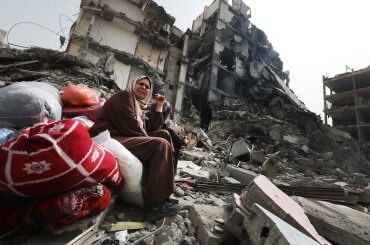Here is a story by New York Times Jerusalem bureau chief Ethan Bronner in yesterday’s paper, anticipating the Israeli defense forces’ official response to the Goldstone Report. Bronner’s story is 99-44/100ths hasbara. He quotes an Israeli general, he quotes Moshe Halbertal. He even gets B’tselem to chime in against the Goldstone report. There is no effort, in the New York Times no less, to have anyone stand up for the Goldstone report, one of the most astonishing moral documents of human rights atrocities that has ever been compiled.
[Close your eyes. Imagine the Times submarining Seymour Hersh by quoting lots of people defending the My Lai massacre.]
Let me give you one example of the bias in this piece. Bronner writes:
The rebuttal will be given to United Nations officials in the coming weeks and its contents will remain under wraps until then. But officers involved in writing the report [i.e., I am serving as a conduit for hasbara] gave some details.
One concerned the destruction of Gaza’s sole flour mill. The Goldstone report asserts that the Bader flour mill “was hit by an airstrike, possibly by an F-16.” The Israeli investigators say they have photographic proof that this is false, that the mill was accidentally hit by artillery in the course of a firefight with Hamas militiamen.
The dispute is significant since the United Nations report asserts that “the destruction of the mill was carried out for the purpose of denying sustenance to the civilian population,” an explicit war crime.
Now let’s go over a few facts. First, I did a search; and it appears that this is the first reference to the el-Bader flour mill destruction in the New York Times. That is to say, despite the fact that Goldstone devoted a whole chapter to the flour mill’s destruction last September, this is the first time Bronner has thought to lift his pen to tell American readers about it. To repeat: the only source of flour inside Gaza is destroyed by the Israeli military, it is cited by an unimpeachable judge who investigated Bosnia and Rwanda as a war crime, and the New York Times correspondent only sees fit to mention it when Israeli officials confidentially tell him the real story.
Second, read Goldstone’s own narrative on the el-Bader flour mill, beginning on paragraph 913 of the report. Goldstone says that after two warnings (12/30/2008 and 1/4/2009) caused the flour mill’s 45 employees to have to evacuate, the mill was struck on Jan. 9 at 3 in the morning by an F-16. And that Apaches then struck it several more times with "missiles" that rendered it inoperative. Then for the next four days, Israeli soldiers occupied the plant–which is in the northwest of Gaza–and evidently used it as a base/machine gun nest. They left "100s" of spent 40 mm shells on the roof.
Goldstone got his information from the Hamada brothers, who own the plant and were interviewed four times, and from visits to the plant. "The Hamada brothers rejected any suggestion that the building was at any time used for any purpose by Palestinian armed groups," Goldstone wrote. There was a high wall around the plant, and it was guarded 24/7. The brothers were issued "Businessman" cards by the Israeli gov’t so as to be able to travel to and fro from Israel, and were in touch with Israeli business associates during the war in an effort to protect their plant. They would never have gotten such cards, the Hamadas said adamantly, if the Israeli gov’t regarded them as a security risk.
Why doesn’t the Times print the Hamada brothers’ story? Why does it believe unnamed gov’t officials? Shouldn’t American readers be given both sides?

